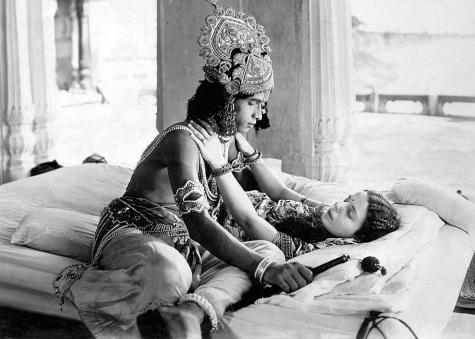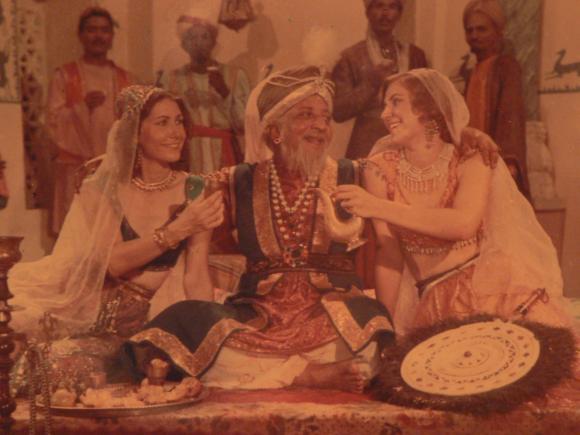Contribute
| Shalom Bollywood At The Boston Jewish Film Festival |
10/23/2018
THE UNTOLD STORY OF INDIAN CINEMA is a feature-length documentary celebrating the all singing, all dancing history of the world’s largest film industry. It reveals the unlikely story of the 2000-year-old Indian Jewish community and its formative place in shaping the world’s largest film industry. When Indian cinema began 100 years ago it was taboo for Hindu and Islamic women to perform on screen, so Indian Jewish women took on female lead roles, which they then dominated for decades. However, because of their stage names people thought they were Muslims or Christians. Until now.... SHALOM BOLLYWOOD is a story told in a cheeky tone in a unique way. As a film about film, the documentary uses film motifs to drive its narrative as a stylistic part of the storytelling. For example, film archive is placed in old Indian style cinemas, there are animated storyboards, and the film is formally structured in three acts. The documentary unabashedly oozes Bollywood as it makes the most of its Bollywood theme: the music rarely stops, and the archive shows Bollywood for all its splendor and glory, or kitsch and stereotypes depending on your perspective. From the origins of Indian cinema to the present, this is an epic tale, and guided by mellifluous narration, its intelligently told infused with lots of humour. SHALOM BOLLYWOOD tells its tale through the lives of nice Jewish girls who became icons at the heart of Indian cinema from the turn of the 20th century to the present day. From the 1920s silent era we meet Sulochana (aka Ruby Myers), arguably the greatest ever female superstar of Indian cinema. In the 1930s there was Miss Rose (aka Rose Ezra) the Queen of the Bollywood’s racy party scene, and in the 1940s Pramila (aka Esther Abraham) who became the country’s first Miss India. Then, in the 1950s and 1960s golden era of Indian cinema, the quintessential Bollywood vamp Nadira (aka Farhat Ezekiel). All these actresses were household names in India and beyond. While the Jewish stars are now deceased, they appear in the film through archive interview (Pramila only), through their films which are used as if it is home video, through animation of their stills, in specifically created storyboards, and with verbatim quotes read by actors as if in the first-person voice of the Jewish stars. Montage sequences from the Jewish stars’ films provide a rare opportunity for viewers to familiarise themselves with their films. In addition to extensive use of film archive and master, the film includes a treasure trove of never before seen stills from the personal collections of the now deceased Jewish stars. It includes information from unpublished autobiographies that have never been made public,and includes rare remastered films not seen for decades. While a predominantly historical story, SHALOM BOLLYWOOD provides great access to Bollywood today as we see descendants of the Jewish stars who work in Indian cinema on film sets, in edit suites and at film launches. They include Bollywood editor Rachel Reubenand scriptwriter/actor Haider Ali, the respective granddaughter and son of Jewish cinematic legends Rose and Pramila. The film explores intergenerational themes of legacy. Rachel and Haider have a primary role in guiding us through the Jewish Bollywood story. Interviewees also include Bollywood A-lister Rishi Kapoor who personally knew and acted with some of the Jewish greats. The film has uplifting and moving moments as we follow the high and lows in the careers and personal lives of the great Jewish stars. We see the often-tumultuous lives, the romance, the peaks and troughs, the parties, the fortunes made and lost, and the challenges they face as youth gives way to age. Once their renowned beauty fades, so did their careers: some emigrated, while others ended their days in loneliness and poverty. The film also shines a light on the Jewish identity of the Jewish stars and its place in the wider cultural mix that is India. The film takes viewers on a journey into Jewish India and Indian society, the former is told in a specific sequence and the latter with colourful montages of the diverse Indian landscapes at key moments in the storytelling. SHALOM BOLLYWOOD is also a story of interfaith harmony and coexistence as we see how Jews,Hindus, Muslims and others coexisted and shared a common love of filmmaking – a poignant tale of coexistence. SHALOM BOLLYWOOD - a documentary about kosher papadams, over the top costumes, religious co-existence, the odd elephant, big screen romance and 12 million cinema tickets. DIRECTOR’S STATEMENT – by Danny Ben-Moshe The first thing people say when I tell them about SHALOM BOLLYWOOD is that I must be a Bollywood aficionado, but I have a confession to make: I’m not. Despite the spread of Bollywood mania around the globe, when I began making this film I had watched a grand total of zero Indian films. However, I do have a longstanding passion for Jewish stories and when I stumbled upon the story of Jews and Indian cinema it captured my imagination. What I didn’t know was that it would be the start of an 11 years journey to tell in a film.My induction into the world of Jews and Bollywood began in the least likely of places:Melbourne Australia. I was working as a professor supervising an international student from India. She ran into some problems with her landlord, a common problem for international students, and I helped her sort out this problem. The student’s father was extremely appreciative of the help I provided and, as I soon learnt, he partook in a common Indian habit of sending gifts. Every few weeks the student entered my office with what can best be described by the Yiddish word shmutzkas, knick-knacks,from pens to pendants began piling up in my desk draw. On one occasion the student entered my office with an article from an Indian newspaper her father thought would be of interest to me. This, I already decided, was destined straight for the recycle bin, but as she handed it to me she said, “It’s an obituary about the Jewish Bollywood actress Nadiraâ€. A Jewish Bollywood actress? I was intrigued, and rather than the recycle bin, I placed the article on the top of my “to read†pile. Nadira, I quickly learnt, was a Jewish superstar of Indian cinema. She not only played the vamp, the infamous drinking and smoking bad girl of Bollywood films, but was widely regarded as the quintessential and greatest vamp Bollywood has ever known. This was in 2006, I had just finished my first documentary and was looking for a story for my second film. It seemed Nadira was it. I went home and with great excitement told my family about Nadira. My then seven-year-old son Zak chipped in “and you should call it Shalom Bollywoodâ€. They say half the success of a film is its title, so once Zak had bestowed the story with a name there was no turning back. I travelled to India for the first time to get a fuller sense of Nadira’s story. Who could I interview about her? What archive would there be? As I met people in the Jewish community and explained I was researching a documentary about Nadira they would ask, “What about Pramila, are you including her?†And “What about Sulochana she was the biggest star of all?†And “Are you including Uncle David, the great Jewish male character actorâ€. I went to India with the intention of making a film about one Jewish film star called Nadira, but it transpired she was the last in a long line of Indian Jewish cinematic greats. Thus began an 11 year odyssey to make ‘Shalom Bollywood’, a film that would tell the story of the multiple Jewish stars of India’s silver screen.Back in the West, when I told people about the film the repertoire became predictable: Q: Were they Hollywood Jews working in India? A: No, Indian Jews. Q: So were they male producers like in Hollywood? A: No, they were actresses front and centre on screen. Q: So were they assimilated like American Jews? A: No, they proudly identified as Jews. It wasn’t just in the West that their story was unknown, but this was also the case in India,as Bollywood figures and film historians who approached to interview them about the Jewish stars did not know these household name actors were Jewish. The all had stage names, not to hide their Jewish identity, but to give them Indian sounding names - Nadira was Farhat Ezekiel, Pramila was Esther Abrahams, Sulochana was Ruby Myers, Uncle David was David Abraham – so as a result no-one knew they were . It was time to set the record straight. It was not just that there were Jewish stars in Indian cinema that inspired me to tell their story, but it was the impact of these stars who had a formative role in shaping what we now know as the worlds’ largest film industry. This stemmed from cultural reasons becausewhen Indian cinema began in the early twentieth century it was taboo for Hindu and Islamic women to perform in public, so female roles were played by men. However, the Jewish community was more liberal and educated so many of the early female stars of Indian cinema were Jewish. These Jewish women not only went where few other Indian women were prepared to go, but pushed the boundaries of Indian cinema by making the most of their femininity. I began to get to know and love these Jewish characters with their massive personalities:Sulochana who caused controversy by reportedly earning more than the Viceroy, Pramila went on to be the first Miss India, Miss Rose the socialite extraordinaire who hosted many after parties, Uncle David who often hosted the Filmfare Awards (India’s equivalent to the Oscars), and of course the sassy Nadira. What also surprised and excited me was their lives were a fascinating intercultural story as these Jewish stars were friends with – and even married – Muslims and coexisted happily. It appeared I had found a country without anti-Semitism. This was turning into a refreshingly positive Jewish story. There were multiple challenges in telling the story, particularly relating to archive. Iquickly learnt that few if any of the films of the early era of Indian cinema survived. Iwanted to include the now deceased Jewish stars through archive interviews and news reports, but despite my best efforts I could not navigate the quagmire of India’s archive bureaucracy. However, necessity is the mother of invention. I began to animate the stills of the Jewish stars, with animation becoming an important storytelling device. Stylistically, given the subject matter of my documentary, I wanted to ensure it had the look and feel of a Bollywood movie. SHALOM BOLLYWOOD is thus infused with multiple singing and dancing scenes, and the music bursts across the entire film. I have now made up for the deficit I had in familiarity with Indian films. While I clearly had a great story, it was hard to get it commissioned. As I pitched it to broadcasters I was told it was either too Jewish, too Indian, too historical, or not historical enough. So, for several years, between making other films, I incrementally put together the pieces of SHALOM BOLLYWOOD. My 7-year-old son who came up with the film’s name is now 18. It’s been a long time coming, but I am delighted that the story of the Jewish superstars of the Indian silver screen will finally be told and that these Jewish greats of Indian cinema will once again hit the silver screen.
You may also access this article through our web-site http://www.lokvani.com/

